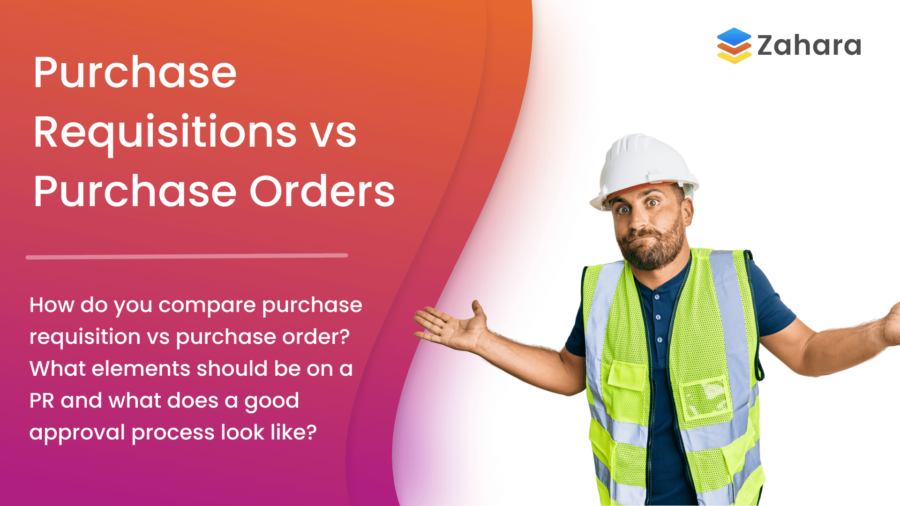A purchase requisition (PR) is a request. The request to buy something for the organisation and that request will likely be subject to an approval process.
Table of Contents
A purchase order is a formal document sent to the supplier/vendor requesting goods or services to be supplied at a specific price and/or within a specific time frame. A purchase order (PO) is basically an offer of a contract.
The Purchase Requisition is an internal document or part of an internal approval process, and the PO is the supplier-facing side of the process.
Do Purchase Requisitions need a separate number or identity?
It’s a good idea to sequence your PRs so that you have a unique identity to link them to the person making the request and the supplier. So start with a number such as 1001 and add on one for each new request – 1002, 1003, 1004.
Once approved, the PR could be converted to a PO. This is how it works in Zahara. Once approved, a PR becomes the PO and can be sent to the supplier. Keeping the same number as the PR could be perfectly sensible, or you could generate a separate PO number.
One reason to generate a separate PO number is if your employees or colleagues are likely to try to shortcut your process and ask for the goods to be supplied by the supplier before an approval process is completed. Our recommendation here would be to remember that this colleague is now likely in breach of your rules and process and, therefore, should be subject to intervention. If your rules are clear and your processes documented, then a separate numbering system might not be likely.
Another reason for separate numbering between the PO and PR is the percentage of rejected PRs. If 90% or more of PRs are approved, then having a separate numbering system seems pointless. If it was less than 50%, then a separate numbering system would make more sense. However, 1 in 2 requests would fail, leaving a large gap in the numbering system.
What should be on a Purchase Requisition?
The key elements of a PR will be:
- A unique number to act as a reference
- Who has made this request?
- Which department does this requestor (originator) belong to?
- The total amount of the PR
- The line item detail of the request – quantities, product codes, descriptions, unit price, unit, price, tax
- The date the goods or services are required by
- The supplier that has been chosen
- Any coding that will be used
- Any budget information
- The approval process
- The audit trail – its really important to have a document of who has approved the request
What elements should be on a PO?
A purchase order will have similar elements of information as a PR, but as it’s a supplier-facing document, it will also have
- Required by date
- Contact details of the buyer
- Terms & Conditions (or links to the T&C used)
- Specific reference (if different to the PR)
- The delivery address
What is a Purchase Requisition approval process?
The PR needs to be approved before it can be converted to a PO and goods supplied by the supplier. A typical approval process will involve one or more people within the organisation who can review the request and decide whether the purchase can be made. Their decision will be made up of:
- Do we need the goods requested?
- The price – is this the right price for these goods?
- The supplier – Has the best supplier been selected?
- Budgets – Does the department or project have enough budget for this?
- Coding – Has the buyer chosen the correct coding for the finance system?
A good approval process will send the approver all of the above information via email, application, or mobile app. The approver can then decide to approve or reject the request.
How many people should approve?
As a rule of thumb, the more expensive an item is requested, the more people will be involved in the sign-off. If the requestor wants to buy office stationery for £200 and buys this every month, then perhaps their line manager will sign off on this and click the approve button. If on the other hand, a director wants to buy a new Tesla for £130K then multiple people, including the board will want to sign off and approve. The most important part here is transparency. Should a higher authority – investors or trustees scrutinise this purchase, the audit trail should be there for all to see.
When to start using PR’s?
As an organisation grows, adding structure and control to every part of the business becomes more important. You can start shouting across the small office, “Ok if I put a stationary order in?” but this starts to fail when multiple people want to buy things and potentially spend the company’s money. Any organisation can introduce a PR system and will know when it’s time. Telltale signs that it’s time:
- The Finance Director is extremely annoyed because they have an invoice for something they never knew about.
- The CEO is livid because you have spent money on something, and they think it’s a waste.
So, to avoid surprises and feel in control, get a PR system to control costs and improve the visibility of all committed spending.

